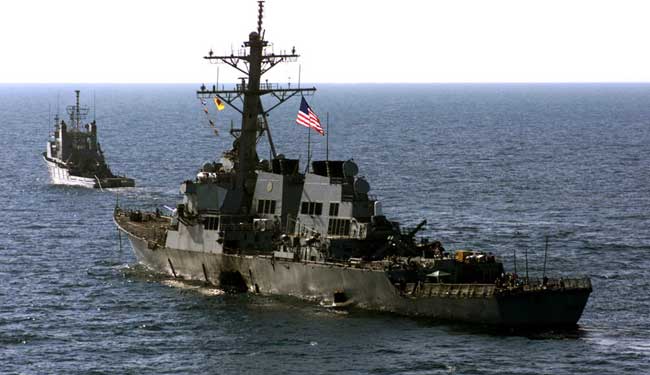
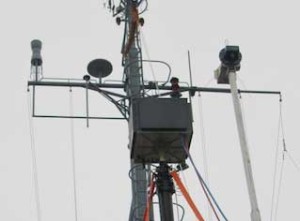
Fighting modern warfare doesn’t mean you face the most sophisticated weapons or strongest enemies. In fact, combat in asymmetric warfare means facing an illusive enemy that, sometime can be equipped with superior weapons, challenging even the strongest armor and most sophisticated platforms. This article addresses countermeasures to a different type of threat – guided missiles fired from the coast, which are becoming relevant in unsecured littorals. Countermeasures used against such threats employ active or passive means. Defense-Update reports from IMDEX.

The attack on USS Cole in Yemen in October 2000 demonstrated the vulnerability of blue-water naval vessels to asymmetric threats. Attacks by swarms of small boats are considered an imminent threat to military vessels, in the Persian Gulf, as well as in other littoral hotspots. But as many navies operating in littorals have realized, precision guided missiles are not less threatening. In fact, the risk of such attacks have caused a number navies facing such perils to avoid presence in certain littoral areas considered too risky. Instead, they prefer to maintain their patrols at safe stand-off distance from the shore, or minimize missions into riverines without the coverage of supporting air or land forces.
While ‘pocket’ anti-ship missiles such as the C-701 are already shipping from Iran to terror groups in the Middle East, simpler anti-tank guided missiles like the TOW II (3+ km range) or KORNET (5 km range) fired from shore pose a significant risk to vessels in their effective range – particularly small patrol boats that patrol close to the coastline or larger vessels passing close to the shore. These vessels are particularly vulnerable when such missiles hit certain weak points.
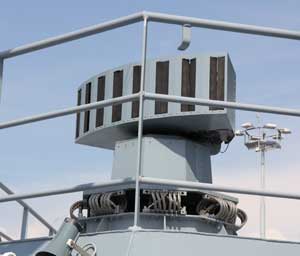
Active protection systems (APS) used on main battle tanks are often too violent for naval vessels. Moreover, ‘Soft Kill’ smart countermeasures are proven relatively effective against most types of guided missiles, when employed in the proper methodology and in time to defeat the threat.
A different system currently under development at IAI ELTA is designed to protection small boats. The core of the system is the new NAVGUARD self-protection system, employing a lightweight four-panel radar based on advanced digital phased array antennae technology. The company is unveiling the system at the IMDEX Asia event in Singapore this week. The radar performs automatic detection, classification and verification of threats, in single or multiple threat scenarios. It is capable of detecting small incoming guided missiles, such as MILAN, SAGGER or FAGOTT, and thus closes a vulnerability gap when it comes to protecting vessels in littoral zones. It can operate independently of all other systems on-board, maintaining full alert to incoming threat at all time. Providing Missile Approach Warning (MAW) the radar triggers various response systems, such as smoke dispensers, chaff or flares. The whole NAVGUARD system can be mounted around the main mast, just below the vessel’s navigation radar. The lightweight system comprising four phased array antennae, main electronic box and two to four countermeasure launchers weighs about 130 kg.
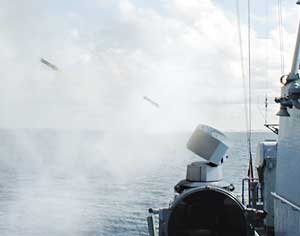
ELTA has already integrated the NAVGUARD with the Rheinmetall Defence MASS system – a programmable countermeasure launcher with omnispectral coverage, designed to protect vessels of any size. Each launcher stores 32 rounds, assuring protection in all relevant wavelengths of the electromagnetic spectrum (radar, infrared, laser, electro-optic, ultraviolet). MASS can be operated either in standalone mode or as an integral part of the ship’s networked command, control and weapon engagement systems. Activation by cueing from the radar enables the system to deploy its effect at the most efficient way. In 2012 the NAVGUARD system was tested for the first time on a German vessel, effectively detecting and classifying guided missiles fired at it from different ranges. Follow-on tests will evaluate the systems’ end-to-end performance. The tests lead by the German Navy and Rheinmetall are conducted under NATO’s ‘Smart Defense’.
Rheinmetall also offers an even smaller launcher known as “Rosy”, modified for naval applications. This 40 mm decoy system produces an instantaneous wall of radar-absorbing smoke/obscurant that makes optical and infrared detection impossible.
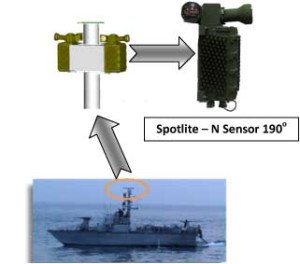
A different type of sensor is the Spotlite N from RAFAEL. This electro-optical sensor effectively detects and localizes firing sources within effective range, enabling the vessel’s crew to engage the threat using on-board weapons such as the Typjhoon stabilized, remortely controlled cannon.
The Spotlite-N is a stabilized, staring EO/IR sensor, a derivative of RAFAEL’s Spotlite system, currently available in dismounted and vehicular configurations. automatically detects, classifies and tracks fire sources such as small arms, rockets, and guided missiles. The system incorporates the sensors and the electronic section including the advanced Multi algorithms/processing computer. The sensor has a field of regard covering – 360 degrees in azimuth and 90 degrees in elevation with multi-target tracking (MTT) capability. The prime mission of the system is to provide the crew with the capability to Detect, Locate, Classify & Track fire sources like: Small arms, rockets, missiles, ATGMS, shells etc. For defense purposes the Spotlite N can slave and direct weapon and other systems (guns, missiles, EO payloads, Radars etc). RAFAEL will display the Spotlite N in IMDEX Asia naval expo this weel in Singapore.
